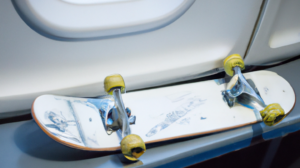Skateboarding has evolved tremendously since its humble beginnings. From the early days when makeshift boards were crafted out of wooden planks and roller skate wheels, skateboards have undergone numerous transformations to become what they are today. While wood has been the go-to material for skateboard construction for decades, recent innovations have opened up a world of possibilities. In this blog post, we will dive deep into alternative materials and explore their advantages and disadvantages in skateboard manufacturing.

The Timeless Appeal of Wood
Wood has long been cherished by skateboarders for its ability to combine strength, flexibility, and durability. Maple, in particular, has emerged as the preferred wood species for skateboard decks due to its exceptional qualities. The natural grain of maple lends aesthetic appeal, while its fibrous structure provides the strength to withstand intense tricks and jumps.

One of the critical advantages of wood is its comparatively low cost and wide availability. Skateboard manufacturers can quickly source maple from sustainable forests, making it an environmentally friendly choice. Additionally, wood is easily customizable, allowing skaters to personalize their boards with unique graphics and designs.
However, wood does have its drawbacks. It can be impacted by moisture, leading to warping or delamination over time if not properly maintained. Additionally, wood decks are prone to chipping and splintering, which can compromise the performance and safety of the skateboard. These limitations have paved the way for exploring alternative materials in skateboard construction.
The Rise of Composite Materials
In recent years, skateboard manufacturers have started turning to composite materials to enhance performance and durability. Composite materials are engineered by combining two or more substances to create a more robust and lightweight material. Two popular composite materials used in skateboard production are carbon fiber and fiberglass.
Carbon Fiber: Strength and Lightweight

Carbon fiber is a material renowned for its exceptional strength-to-weight ratio. It is created by weaving carbon strands together and impregnating them with epoxy resin. The resulting material is incredibly lightweight while retaining impressive strength and stiffness. Carbon fiber decks offer enhanced pop and responsiveness, allowing skaters to achieve greater heights and perform complex tricks.
Moreover, carbon fiber’s inherent flexibility can provide a unique riding experience. It offers a slightly different feel than traditional wooden decks, adapting to the skater’s movements and providing a lively, spring-like response. The versatility of carbon fiber allows manufacturers to create decks with varying degrees of flex to cater to different styles and preferences.
However, carbon fiber decks come at a cost. The production process is more complex and expensive than traditional wooden decks, resulting in a higher price point. Additionally, while carbon fiber is solid, it is also brittle. Carbon fiber decks are more susceptible to cracking or shattering upon heavy impact, making them less forgiving in certain situations.
Fiberglass: Flex and Resilience

Fiberglass is another composite material frequently used in skateboard manufacturing. It is created by layering thin strands of glass onto a mold and saturating them with epoxy resin. The fiberglass reinforces the resin, resulting in a lightweight yet strong material.
Fiberglass decks offer a unique blend of flex and resilience. They are known for their ability to absorb shock and vibrations, providing a smoother ride and reducing fatigue during long sessions. The added flexibility allows for greater control and maneuverability, making fiberglass decks popular among street and park skaters.
However, fiberglass decks also have their downsides. Like carbon fiber, they are more prone to breaking upon heavy impact than wooden decks. Additionally, the performance of fiberglass decks can diminish over time due to wear and tear. The deck’s surface may become rough, compromising the board’s slideability.
Emerging Materials: The Future of Skateboard Construction
In addition to carbon fiber and fiberglass, skateboard manufacturers are constantly exploring new materials to push the boundaries of performance and durability. Some emerging materials in skateboard construction include bamboo, aluminum, and composites featuring natural fibers.
Bamboo: Sustainable Strength
Bamboo has gained popularity as a sustainable and eco-friendly alternative to traditional wood. It is extreme, rivaling or even surpassing the performance of maple decks. Bamboo’s natural flexibility allows for a responsive ride, while its inherent shock-absorbing properties make it a comfortable choice.
Furthermore, bamboo is a rapidly renewable resource that proliferates, making it an appealing option for environmentally conscious skaters. Its aesthetic appeal, with distinct patterns and colors, adds a unique touch to the overall design of a skateboard deck.
However, bamboo decks may only be suitable for some skaters. While they offer great flexibility and responsiveness, some riders may find them too soft or lacking in pop. Additionally, bamboo decks are more expensive than traditional wooden decks due to the higher cost of sourcing and processing bamboo.
Aluminum: Unparalleled Durability
Aluminum decks depart from the traditional wooden construction that skaters are accustomed to. These decks are made entirely of aluminum, resulting in an incredibly durable and long-lasting board. Aluminum decks can withstand immense pressure, making them an excellent choice for riders who frequently perform high-impact tricks.
Moreover, aluminum offers excellent slide ability, allowing skaters to grind on rails and ledges effortlessly. Its slick surface reduces friction, resulting in smooth and controlled slides. Aluminum decks also boast impressive weight savings, making them lighter than wooden decks without compromising strength.
However, aluminum decks have limitations that may discourage some skaters. The rigidity of aluminum can affect the overall feel and ride experience, with a stiffer and less forgiving response than wooden decks. The solid construction also means that aluminum decks transmit vibrations more efficiently, potentially causing discomfort during extended periods of riding.
Natural Fiber Composites: A Sustainable Blend
Natural fiber composites combine the advantages of traditional materials with the sustainability of natural fibers. These decks incorporate flax, hemp, or bamboo fibers woven into a resin matrix. The resulting composite offers a unique balance of strength, flexibility, and eco-friendliness.
Natural fiber composites provide a smooth and lively ride, while their shock-absorbing properties reduce fatigue and strain on the skater’s body. These materials are also more forgiving than carbon fiber or fiberglass, as they can exhibit a degree of flex and resilience similar to wooden decks.
However, natural fiber composites have their limitations. They may offer a different level of pop and responsiveness than carbon fiber or fiberglass decks. Moreover, the production process of these composites can be more complex and costly, resulting in higher retail prices.
Conclusion: The Material Revolution in Skateboarding
As skateboarders continue to push the limits of what can be achieved on four wheels, the materials used in skateboard construction are evolving accordingly. While wood remains a timeless classic, alternative materials such as carbon fiber, fiberglass, bamboo, aluminum, and natural fiber composites provide skaters with new possibilities for performance, durability, and sustainability.
Each material comes with its own set of advantages and disadvantages, catering to different riding styles, preferences, and budgets. Whether you prioritize the natural aesthetic of wood, the lightweight strength of carbon fiber, the flex and resilience of fiberglass, the eco-friendliness of bamboo, the durability of aluminum, or the balance of natural fiber composites, there is an option for every skateboarder.
As a skateboard manufacturer, it is essential to consider the demands and needs of the riders when choosing the materials for your boards. Experimentation with different materials can lead to unique and innovative designs that push the boundaries of skateboarding.
Ultimately, the choice of material should align with your brand identity, the intended use of the skateboard, and the desires of your target audience. Embrace the material revolution in skateboarding and dare to explore new possibilities beyond traditional wood. The skateboarding community is eagerly awaiting the next breakthrough in skateboard construction, and it could be your brand leading the way.
Now, it’s time to hit the streets and let your skateboard do the talking. Keep shredding and pushing the boundaries of what’s possible on four wheels!
Resources:
- Comparing Skateboard Deck Materials
- Carbon Fiber Reinforced Polymer Composites
- Difference Between Fiberglass and Carbon Fiber
- Bamboo vs Maple Skateboard Decks
- Aluminum Skateboard Decks: Pros and Cons
- Natural Fiber-Reinforced Composites in Modern Engineering







